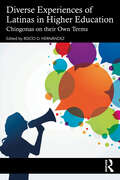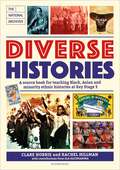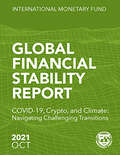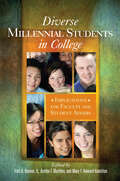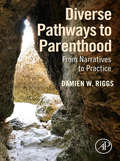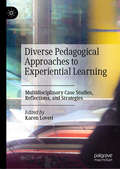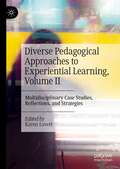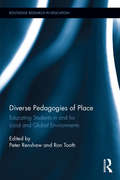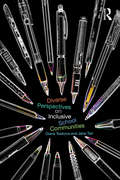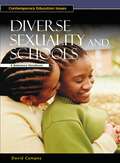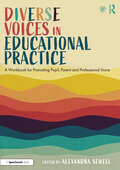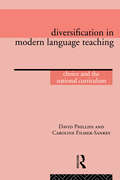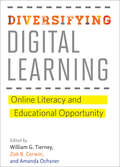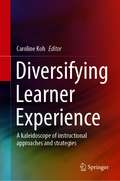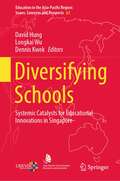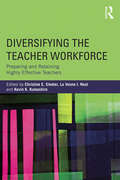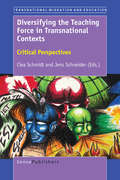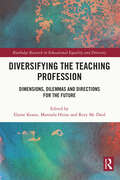- Table View
- List View
Diverse Experiences of Latinas in Higher Education: Chingonas on their Own Terms
By sharing the collective experiences of Latinas in Higher Education, this book provides a diverse range of empowering testimonios from Chingonas living on their own terms, who are defining professionalism for themselves. Chingona means "badass" and is a term that has been reappropriated by Latinas as an expression of empowerment both inside and outside of education. This anthology is a collection of twelve voices, representative of the experiences of empowered Chingonas across various roles in higher education who identify as Latinas. This volume shares the knowledge of Chingona Latina women, including their thoughts around authenticity, identity, and the disruption of dominant cultural experiences within the institution. It also seeks to help other Latinas realize that they are not alone in their experiences with higher education. This book includes questions for reflection and writing prompts, allowing readers to consider their own lived experiences and envision change. This collection will be important reading for undergraduate and postgraduate students in education-related programs, including Higher Education Studies and Educational Leadership, as well as courses in Ethnic Studies, Chicana/o/x Studies, Latinx/a/o Studies and Women’s Studies. It also offers an invaluable learning opportunity for higher education professionals, leaders, and administrators, especially within student affairs.
Diverse Histories: A source book for teaching Black, Asian and minority ethnic histories at Key Stage 3, in association with The National Archives
by Clare Horrie Rachel HillmanThe ultimate resource for developing a diverse history curriculum in secondary schools.Exclusively based on historical sources from The National Archives, this book is an indispensable tool for history departments to diversify their Key Stage 3 curriculum and uncover important stories from British history that are often missing from textbooks.With downloadable sources, exciting lesson plans, activities and photocopiable resources, this is a must-have book for every humanities department in every secondary school. Allowing for a unique enquiry-based approach for teaching history, this is a flexible resource that will save teachers hours of searching for authentic sources online and ensure that students develop a diverse knowledge of British history.In addition to John Blanke, Euan Lucie-Smith, Princess Sophia Duleep Singh and the arrival of the Empire Windrush, students will learn about key figures and events in British history that don't always come up in history lessons. From Shapurji Saklatvala, one of the first people of Indian heritage to become an MP in Britain, to the British Black Power movement in the 1970s, Diverse Histories allows teachers to offer comprehensive and inclusive history lessons that both prepare students for their assessments and enrich their learning.
Diverse Histories: A source book for teaching Black, Asian and minority ethnic histories at Key Stage 3, in association with The National Archives (The\johns Hopkins University Studies In Historical And Political Science Ser. #123)
by Clare Horrie Rachel HillmanThe ultimate resource for developing a diverse history curriculum in secondary schools.Exclusively based on historical sources from The National Archives, this book is an indispensable tool for history departments to diversify their Key Stage 3 curriculum and uncover important stories from British history that are often missing from textbooks.With downloadable sources, exciting lesson plans, activities and photocopiable resources, this is a must-have book for every humanities department in every secondary school. Allowing for a unique enquiry-based approach for teaching history, this is a flexible resource that will save teachers hours of searching for authentic sources online and ensure that students develop a diverse knowledge of British history.In addition to John Blanke, Euan Lucie-Smith, Princess Sophia Duleep Singh and the arrival of the Empire Windrush, students will learn about key figures and events in British history that don't always come up in history lessons. From Shapurji Saklatvala, one of the first people of Indian heritage to become an MP in Britain, to the British Black Power movement in the 1970s, Diverse Histories allows teachers to offer comprehensive and inclusive history lessons that both prepare students for their assessments and enrich their learning.
Diverse Millennial Students in College: Implications for Faculty and Student Affairs
by Fred A. Bonner Aretha F. Marbley Mary F. Howard-HamiltonWhile many institutions have developed policies to address the myriad needs of Millennial college students and their parents, inherent in many of these initiatives is the underlying assumption that this student population is a homogeneous group. This book is significant because it addresses and explores the characteristics and experiences of Millennials from an array of perspectives, taking into account not only racial and ethnic identity but also cultural background, sexual orientation, and socioeconomic status differences—all factors contributing to how these students interface with academe.In providing a “voice” to “voiceless” populations of African American, Asian American, Bi/Multi-Racial, Latino, Native American, and LGBT millennial college students, this book engages with such questions as: Does the term “Millennial” apply to these under-represented students? What role does technology, pop culture, sexual orientation, and race politics play in the identity development for these populations? Do our current minority development theories apply to these groups? And, ultimately, are higher education institutions prepared to meet both the cultural and developmental needs of diverse minority groups of Millennial college students?” This book is addressed primarily to college and university administrators and faculty members who seek greater depth and understanding of the issues associated with diverse Millennial college student populations. This book informs readers about the ways in which this cohort differs from their majority counterparts to open a dialogue about how faculty members and administrators can meet their needs effectively both inside and outside the classroom. It will also be of value to student affairs personnel, students enrolled in graduate level courses in higher education and other social science courses that explore issues of college student development and diversity, particularly students planning to work with diverse Millennial college students in both clinical or practical work settings.Contributors: Rosie Maria Banda; Fred Bonner, II; Lonnie Booker, Jr.; Brian Brayboy; Mitchell Chang; Andrea Domingue; Tonya Driver; Alonzo M. Flowers; Gwen Dungy; Jami Grosser; Kandace Hinton; Mary Howard-Hamilton; Tom Jackson, Jr.; Aretha F. Marbley; Samuel Museus; Anna Ortiz; Tammie Preston-Cunningham; Nana Osei-Kofi; Kristen Renn; Petra Robinson; Genyne Royal; Victor Saenz; Rose Anna Santos; Mattyna Stephens; Terrell Strayhorn; Theresa Survillion; Nancy Jean Tubbs; Malia Villegas; Stephanie J. Waterman; Nick Zuniga.
Diverse Millennial Students in College: Implications for Faculty and Student Affairs
While many institutions have developed policies to address the myriad needs of Millennial college students and their parents, inherent in many of these initiatives is the underlying assumption that this student population is a homogeneous group. This book is significant because it addresses and explores the characteristics and experiences of Millennials from an array of perspectives, taking into account not only racial and ethnic identity but also cultural background, sexual orientation, and socioeconomic status differences—all factors contributing to how these students interface with academe.In providing a “voice” to “voiceless” populations of African American, Asian American, Bi/Multi-Racial, Latino, Native American, and LGBT millennial college students, this book engages with such questions as: Does the term “Millennial” apply to these under-represented students? What role does technology, pop culture, sexual orientation, and race politics play in the identity development for these populations? Do our current minority development theories apply to these groups? And, ultimately, are higher education institutions prepared to meet both the cultural and developmental needs of diverse minority groups of Millennial college students?” This book is addressed primarily to college and university administrators and faculty members who seek greater depth and understanding of the issues associated with diverse Millennial college student populations. This book informs readers about the ways in which this cohort differs from their majority counterparts to open a dialogue about how faculty members and administrators can meet their needs effectively both inside and outside the classroom. It will also be of value to student affairs personnel, students enrolled in graduate level courses in higher education and other social science courses that explore issues of college student development and diversity, particularly students planning to work with diverse Millennial college students in both clinical or practical work settings.Contributors: Rosie Maria Banda; Fred Bonner, II; Lonnie Booker, Jr.; Brian Brayboy; Mitchell Chang; Andrea Domingue; Tonya Driver; Alonzo M. Flowers; Gwen Dungy; Jami Grosser; Kandace Hinton; Mary Howard-Hamilton; Tom Jackson, Jr.; Aretha F. Marbley; Samuel Museus; Anna Ortiz; Tammie Preston-Cunningham; Nana Osei-Kofi; Kristen Renn; Petra Robinson; Genyne Royal; Victor Saenz; Rose Anna Santos; Mattyna Stephens; Terrell Strayhorn; Theresa Survillion; Nancy Jean Tubbs; Malia Villegas; Stephanie J. Waterman; Nick Zuniga.
Diverse Pathways to Parenthood: From Narratives to Practice
by Damien RiggsDiverse Pathways to Parenthood: From Narratives to Practice is a timely contribution to the study of reproduction and parenthood. Drawing on a wide breadth of projects, this book covers topics such as first time parents, donor conception, pregnancy loss, surrogacy, lesbian, gay and/or transgender parenting, fostering and adoption, grandparenting, and human/animal kinship. By presenting individual narratives focused on reproduction and parenthood, this book successfully translates empirical research into practical, applied outcomes that will be of use for all those working in the fields of reproduction and parenthood. Including recommendations for fertility specialists, educators, child protection agencies, reproductive counselors, and policy makers, Diverse Pathways to Parenthood: From Narratives to Practice is a vital new resource that will help guide practice into the future. As a contribution to the field of critical kinship studies, this book heralds new directions for the study of kinship, by revisiting as well as reimagining how we think about, research, and respond to a diversity of kinship forms.Includes over 70 narratives representative of hundreds of interviews collected as a part of 15 research projects undertaken over the past decadeSupported by a companion website that provides further materials and information: www.diversepathways.com Translates critical kinship studies theory into applied tools for practice in the fields of reproduction and parenthood
Diverse Pedagogical Approaches to Experiential Learning: Multidisciplinary Case Studies, Reflections, and Strategies
by Karen LovettThis edited collection offers a unique multidisciplinary perspective into the many factors that go into designing, facilitating, expanding, and assessing experiential learning (EL) from the perspective of faculty and staff educators. The editor and contributors bring decades of expertise with different forms of EL, including community-engaged learning, education abroad, internships, and more. Chapters offer case studies and reflections which highlight personal experiences and anecdotes which illuminate the realities of experiential teaching and learning. Through these stories and narratives, readers may better understand what doing EL entails on an everyday basis—both on a local and global scale—and learn how to enhance support and resources for experiential educators on college and university campuses.
Diverse Pedagogical Approaches to Experiential Learning, Volume II: Multidisciplinary Case Studies, Reflections, and Strategies
by Karen LovettThis second volume of Diverse Pedagogical Approaches to Experiential Learning (Palgrave, 2020) contains a new collection of experiential learning (EL) reflections, case studies, and strategies written by twenty-eight authors across sixteen academic disciplines. Like the first volume, the chapters describe the process of developing, implementing, facilitating, expanding, and assessing EL in courses, programs, and centers both locally and globally. The authors take on new themes in this collection, including discussions on the intersections of experiential learning with race and privilege, cross-cultural competencies, power and gender, professional development and vocational discernment, self-inquiry and reflection, social justice, and more. The authors also address the importance of adapting new pedagogical approaches to EL in response to challenges in higher education presented by the global coronavirus pandemic.
Diverse Pedagogies of Place: Educating Students in and for Local and Global Environments (Routledge Research in Education)
by Peter Renshaw Ron ToothDiverse Pedagogies of Place presents eight original place-responsive pedagogies that address a question of paramount importance in today’s world: how do we educate the next generation of students to confront the challenges of global climate change and the on-going degradation of natural environments? Each place-responsive pedagogy is a result of innovative environmental educators’ long-term engagement with particular places, and demonstrates that personal connectedness is crucial to effective environmental education. Professional learning and teacher collaboration is an important theme throughout the book, and the editors discuss how teachers could adapt the learning activities and teaching strategies found in the book in order to create their own place-responsive pedagogies. Each case study provides a rich account of how students can learn to be attentive and draws upon a common analytical framework derived from recent theorisation of place that highlights the centrality of stories-in-place, embodiment, and contestation. The authors present detailed and persuasive evidence that place-responsive pedagogies enable students to construct their own identities, as well as develop commitments and a deeper knowledge of the environments that surround them. A work of international relevance, Diverse Pedagogies of Place will appeal to academics, researchers and postgraduate students in the fields of environmental education and sustainability, place-based education, outdoor learning, professional learning and teacher development, as well as policymakers and environmental educators.
Diverse Pedagogies of Place: Educating Students in and for Local and Global Environments (Routledge Research in Education)
by Peter Renshaw Ron ToothDiverse Pedagogies of Place presents eight original place-responsive pedagogies that address a question of paramount importance in today’s world: how do we educate the next generation of students to confront the challenges of global climate change and the on-going degradation of natural environments? Each place-responsive pedagogy is a result of innovative environmental educators’ long-term engagement with particular places, and demonstrates that personal connectedness is crucial to effective environmental education. Professional learning and teacher collaboration is an important theme throughout the book, and the editors discuss how teachers could adapt the learning activities and teaching strategies found in the book in order to create their own place-responsive pedagogies. Each case study provides a rich account of how students can learn to be attentive and draws upon a common analytical framework derived from recent theorisation of place that highlights the centrality of stories-in-place, embodiment, and contestation. The authors present detailed and persuasive evidence that place-responsive pedagogies enable students to construct their own identities, as well as develop commitments and a deeper knowledge of the environments that surround them. A work of international relevance, Diverse Pedagogies of Place will appeal to academics, researchers and postgraduate students in the fields of environmental education and sustainability, place-based education, outdoor learning, professional learning and teacher development, as well as policymakers and environmental educators.
Diverse Perspectives on Inclusive School Communities
by Diana Tsokova Jane TarrWhat is an inclusive school community? How do stakeholders perceive their roles and responsibilities towards inclusive school communities? How can school communities become more inclusive through engagement with individual perspectives? Diverse Perspectives on Inclusive School Communities captures and presents the voices of a wide range of stakeholders including young people and their parents, teachers, support staff, educational psychologists, social workers, health practitioners and volunteers in producing a collection of varied perspectives on inclusive education. In this fascinating book, Tsokova and Tarr uniquely assemble a compilation of accounts collected through in-depth interviews with over twenty-five participants, met throughout the course of their professional lives. The authors focus on how we can ensure all children receive the best education and social provision in inclusive school communities. Key learning points in this book emphasise: links between early life and educational experiences; constructions of inclusion; an understanding of roles and responsibilities; the power of agency in relation to inclusive school communities. The text contributes to current debates surrounding educational policy initiatives, highlighting similarities and differences across people and professions, and illuminating a way forward for the consideration of a broader range of insight into the concept of inclusion and ways this can be achieved. Including both UK and international perspectives that illustrate different stages of the inclusive education process, this text will be invaluable to anyone affiliated with inclusive schooling in a personal or professional capacity.
Diverse Perspectives on Inclusive School Communities
by Diana Tsokova Jane TarrWhat is an inclusive school community? How do stakeholders perceive their roles and responsibilities towards inclusive school communities? How can school communities become more inclusive through engagement with individual perspectives? Diverse Perspectives on Inclusive School Communities captures and presents the voices of a wide range of stakeholders including young people and their parents, teachers, support staff, educational psychologists, social workers, health practitioners and volunteers in producing a collection of varied perspectives on inclusive education. In this fascinating book, Tsokova and Tarr uniquely assemble a compilation of accounts collected through in-depth interviews with over twenty-five participants, met throughout the course of their professional lives. The authors focus on how we can ensure all children receive the best education and social provision in inclusive school communities. Key learning points in this book emphasise: links between early life and educational experiences; constructions of inclusion; an understanding of roles and responsibilities; the power of agency in relation to inclusive school communities. The text contributes to current debates surrounding educational policy initiatives, highlighting similarities and differences across people and professions, and illuminating a way forward for the consideration of a broader range of insight into the concept of inclusion and ways this can be achieved. Including both UK and international perspectives that illustrate different stages of the inclusive education process, this text will be invaluable to anyone affiliated with inclusive schooling in a personal or professional capacity.
Diverse Sexuality and Schools: A Reference Handbook (Contemporary Education Issues)
by David CamposAn overview of the gay, lesbian, bisexual, and transgender (GLBT) students in our schools—what they endure, their special needs, and the programs and groups that support them.Diverse Sexuality and Schools: A Reference Handbook is an eye-opening report on gay, lesbian, bisexual, and transgender youth in our schools—the isolation they feel, the hostilities they face, their unique developmental and emotional needs, and the innovative ways schools, communities, and organizations are working to support them.Author David Campos offers a compelling, often harrowing, tour of the lives of GLBT students, including what researchers have learned over the past half-century and what the schools, the courts, and the government are doing to keep them safe regardless of their sexual orientation. But perhaps the book's greatest impact comes from the way Campos gives voice to this often neglected population, providing a forum for these students' painful testimonies of harassment, violence, and despair.
Diverse Voices in Educational Practice: A Workbook for Promoting Pupil, Parent and Professional Voice
by Alexandra SewellThis practical workbook supports teachers seeking to sensitively understand and respond to the opinions and perceptions of critical stakeholders in student learning and development; pupil voice, parent voice, and professional voice are introduced and explored. A wide range of expert educator and academic contributors ensure that diverse voices are meaningfully understood, with chapters placing an emphasis on minority and traditionally marginalised groups, including SEND, LGBTQIA+, and Global Majority students. The workbook advocates a clear and inclusive ethos and demonstrates how voice work can help to decolonise the curriculum, promote a positive LGBTQIA+ friendly school climate, and value pupil involvement. Moments for personal reflection, activities, and action plans allow practitioners to consider the role they play in facilitating the effective inclusion of those not normally involved in knowledge construction and decision-making processes. Blending key theory with practical strategies and takeaways, this workbook is an essential tool for practising primary and secondary teachers and teaching assistants, as well as educational psychologists, school counsellors, and other educational professionals interested in promoting inclusive voice practices.
Diverse Voices in Educational Practice: A Workbook for Promoting Pupil, Parent and Professional Voice
by Alexandra SewellThis practical workbook supports teachers seeking to sensitively understand and respond to the opinions and perceptions of critical stakeholders in student learning and development; pupil voice, parent voice, and professional voice are introduced and explored. A wide range of expert educator and academic contributors ensure that diverse voices are meaningfully understood, with chapters placing an emphasis on minority and traditionally marginalised groups, including SEND, LGBTQIA+, and Global Majority students. The workbook advocates a clear and inclusive ethos and demonstrates how voice work can help to decolonise the curriculum, promote a positive LGBTQIA+ friendly school climate, and value pupil involvement. Moments for personal reflection, activities, and action plans allow practitioners to consider the role they play in facilitating the effective inclusion of those not normally involved in knowledge construction and decision-making processes. Blending key theory with practical strategies and takeaways, this workbook is an essential tool for practising primary and secondary teachers and teaching assistants, as well as educational psychologists, school counsellors, and other educational professionals interested in promoting inclusive voice practices.
Diversification in Modern Language Teaching: Choice and the National Curriculum
by Caroline Filmer-Sankey David PhillipsAs the effects of European integration become more widely felt the effective teaching of modern languages is moving towards the centre of the educational agenda and more and more schools are considering starting pupils on a first foreign language other than French - a development encouraged by the National Curriculum orders in Modern Languages. Diversification in Modern Language Teaching gives language teachers and heads of department the evidence upon which to decide if diversification is right for them. It looks at the factors which effect children's learning in this area and at the managerial issues both within and outside the school. Throughout it argues that the decision must be a purely educational one, based on pupil motivation and accessibility as well as on particular local strengths among staff and parents.
Diversification in Modern Language Teaching: Choice and the National Curriculum
by Caroline Filmer-Sankey David PhillipsAs the effects of European integration become more widely felt the effective teaching of modern languages is moving towards the centre of the educational agenda and more and more schools are considering starting pupils on a first foreign language other than French - a development encouraged by the National Curriculum orders in Modern Languages. Diversification in Modern Language Teaching gives language teachers and heads of department the evidence upon which to decide if diversification is right for them. It looks at the factors which effect children's learning in this area and at the managerial issues both within and outside the school. Throughout it argues that the decision must be a purely educational one, based on pupil motivation and accessibility as well as on particular local strengths among staff and parents.
Diversifying Digital Learning: Online Literacy and Educational Opportunity (Tech.edu: A Hopkins Series on Education and Technology)
by William G. Tierney Zo;« B. Corwin Amanda OchsnerMany schools and programs in low-income neighborhoods lack access to the technological resources, including equipment and Internet service, that those in middle- and upper-income neighborhoods have at their fingertips. This inequity creates a persistent digital divide;¢;‚¬;€?not a simple divide in access to technology per se, but a divide in both formal and informal digital literacy that further marginalizes youths from low-income, minoritized, and first-generation communities.Diversifying Digital Learning outlines the pervasive problems that exist with ensuring digital equity and identifies successful strategies to tackle the issue. Bringing together top scholars to discuss how digital equity in education might become a key goal in American education, this book is structured to provide a framework for understanding how historically underrepresented students most effectively engage with technology;¢;‚¬;€?and how institutions may help or hinder students;€™ ability to develop and capitalize on digital literacies.This book will appeal to readers who are well versed in the diverse uses of social media and technologies, as well as less technologically savvy educators and policy analysts in educational organizations such as schools, afterschool programs, colleges, and universities. Addressing the intersection of digital media, race/ethnicity, and socioeconomic class in a frank manner, the lessons within this compelling work will help educators enable students in grades K;€“12, as well as in postsecondary institutions, to participate in a rapidly changing world framed by shifting new media technologies.Contributors: Young Whan Choi, Zo;« B. Corwin, Christina Evans, Julie Flapan, Joanna Goode, Erica Hodgin, Joseph Kahne, Suneal Kolluri, Lynette Kvasny, David J. Leonard, Jane Margolis, Crystle Martin, Safiya Umoja Noble, Amanda Ochsner, Fay Cobb Payton, Antar A. Tichavakunda, William G. Tierney, S. Craig Watkins
Diversifying Digital Learning: Online Literacy and Educational Opportunity (Tech.edu: A Hopkins Series on Education and Technology)
by William G. Tierney Zo;« B. Corwin Amanda OchsnerMany schools and programs in low-income neighborhoods lack access to the technological resources, including equipment and Internet service, that those in middle- and upper-income neighborhoods have at their fingertips. This inequity creates a persistent digital divide;¢;‚¬;€?not a simple divide in access to technology per se, but a divide in both formal and informal digital literacy that further marginalizes youths from low-income, minoritized, and first-generation communities.Diversifying Digital Learning outlines the pervasive problems that exist with ensuring digital equity and identifies successful strategies to tackle the issue. Bringing together top scholars to discuss how digital equity in education might become a key goal in American education, this book is structured to provide a framework for understanding how historically underrepresented students most effectively engage with technology;¢;‚¬;€?and how institutions may help or hinder students;€™ ability to develop and capitalize on digital literacies.This book will appeal to readers who are well versed in the diverse uses of social media and technologies, as well as less technologically savvy educators and policy analysts in educational organizations such as schools, afterschool programs, colleges, and universities. Addressing the intersection of digital media, race/ethnicity, and socioeconomic class in a frank manner, the lessons within this compelling work will help educators enable students in grades K;€“12, as well as in postsecondary institutions, to participate in a rapidly changing world framed by shifting new media technologies.Contributors: Young Whan Choi, Zo;« B. Corwin, Christina Evans, Julie Flapan, Joanna Goode, Erica Hodgin, Joseph Kahne, Suneal Kolluri, Lynette Kvasny, David J. Leonard, Jane Margolis, Crystle Martin, Safiya Umoja Noble, Amanda Ochsner, Fay Cobb Payton, Antar A. Tichavakunda, William G. Tierney, S. Craig Watkins
Diversifying Learner Experience: A kaleidoscope of instructional approaches and strategies
by Caroline KohThis book brings together strategies and innovations that educators from diverse educational contexts have conceptualized and implemented to cater to differences in academic ability, as well as in other domains such as psychosocial contexts and developmental needs. The emergence of IT and new technologies have altered the educational landscape and opened a multitude of opportunities for diverse modes of instruction catering to diverse student populations.The book addresses the gap in the literature with evidence-based reports of innovative strategies and approaches that are grounded in educational research. It identifies student differences in terms of academic ability and also, with regard to their cultural and social background, their developmental and psycho-emotional needs. It examines how new technologies are used in instructional approaches and how these innovative strategies diversify learner experiences. The book is a valuable resource to practitioners, researchers and educational administrators.
Diversifying Schools: Systemic Catalysts for Educational Innovations in Singapore (Education in the Asia-Pacific Region: Issues, Concerns and Prospects #61)
by David Hung Longkai Wu Dennis KwekThis book discusses the strategies that the Singapore Education System has embarked to encourage school change and innovations. It documents the change journey of Specialized Schools and Future Schools in Singapore with a view to understand the key tenets that enable school wide change and reform. The intents for change and reform are to anchor the education system to the basic foundations and principles of education and yet enable the system as a whole to be malleable to change and globalization. It shows how Singapore enables diversity within a structured environment through innovations in Specialized and Future Schools, and highlights the systemic rationale behind various efforts in Specialized and Future Schools and the kinds of adaptations schools have made to leverage structures and make adjustments for their contexts.
Diversifying the Teacher Workforce: Preparing and Retaining Highly Effective Teachers
by Christine E. Sleeter La Vonne Neal Kevin K. KumashiroDiversifying the Teacher Workforce critically examines efforts to diversify the teaching force and narrow the demographic gap between who teaches and who populates U.S. classrooms. While the demographic gap is often invoked to provide a needed rationale for preparing all teachers, and especially White teachers, to work with students of color, it is far less often invoked in an effort to examine why the teaching force remains predominantly White in the first place. Based on work the National Association for Multicultural Education is engaged in on this phenomenon, this edited collection brings together leading scholars to look closely at this problem. They examine why the teaching force is predominantly White from historical as well as contemporary perspectives, showcase and report available data on a variety of ways this problem is being tackled at the pre-service and teacher credentialing levels, and examine how a diverse and high-quality teaching force can be retained and thrive. This book is an essential resource for any educator interested in exploring race within the context of today’s urban schools.
Diversifying the Teacher Workforce: Preparing and Retaining Highly Effective Teachers
by Christine E. Sleeter La Vonne Neal Kevin K. KumashiroDiversifying the Teacher Workforce critically examines efforts to diversify the teaching force and narrow the demographic gap between who teaches and who populates U.S. classrooms. While the demographic gap is often invoked to provide a needed rationale for preparing all teachers, and especially White teachers, to work with students of color, it is far less often invoked in an effort to examine why the teaching force remains predominantly White in the first place. Based on work the National Association for Multicultural Education is engaged in on this phenomenon, this edited collection brings together leading scholars to look closely at this problem. They examine why the teaching force is predominantly White from historical as well as contemporary perspectives, showcase and report available data on a variety of ways this problem is being tackled at the pre-service and teacher credentialing levels, and examine how a diverse and high-quality teaching force can be retained and thrive. This book is an essential resource for any educator interested in exploring race within the context of today’s urban schools.
Diversifying the Teaching Force in Transnational Contexts: Critical Perspectives (Transnational Migration and Education)
by Clea Schmidt Jens Schneider"Diversifying the teaching force has become a priority in many migrant-receiving jurisdictions worldwide with the growing mismatch between the ethnic backgrounds, cultures, languages, and religions of teachers and those of students and families. Arguments for diversification tend to be couched in terms of disproportionate representation and students from minority backgrounds needing positive role models, yet research identifies other compelling reasons for diversification, including the fact that teachers of migrant backgrounds often possess outstanding qualifications when multilingualism and internationally obtained education and experience are taken into account, and the fact that all students, including majority-background students, benefit from a diversity of role models in schools. Nevertheless, the process of diversification is fraught with complexity. Depending on the context, systemic discrimination, an oversupply of teachers in the profession generally, and outdated hiring policies and practices can all impede efforts to diversify the teaching force.This volume comprises original research from Canada, the U.S., Germany, Ireland, Scotland, and England that problematizes issues of diversifying the teaching force and identifies promising practices. A foreword written by Charlene Bearhead of the National Centre for Truth and Reconciliation questions the very purpose of education in and for diverse societies. An introduction written by the editors defines key concepts and establishes a rationale for diversifying the teaching force in migrant-receiving contexts. Following this, key international scholars offer empirical perspectives using a range of methodologies and theories rooted in critical social science paradigms. The volume informs future research, programming, and policy development in this area."
Diversifying the Teaching Profession: Dimensions, Dilemmas and Directions for the Future (Routledge Research in Educational Equality and Diversity)
by Elaine Keane Manuela Heinz Rory Mc DaidThis edited volume is about diversifying the teaching profession. It is unique in its inclusion of multiple dimensions of diversity; its chapters focus on a wide range of under-represented groups, including those from lower socio-economic groups, Black and minority ethnic groups, migrants, the Travelling community, the Deaf community, the LGBTQI+ community and those of mature age. The book includes contributions from Australia, England, Iceland, Portugal and Scotland, as well as a number of chapters from the Irish context, mostly emanating from projects funded under Ireland’s Higher Education Authority’s Programme for Access to Higher Education (PATH): Strand 1—Equity of Access to Initial Teacher Education. The book also critically engages the rationale for diversifying the profession, arguing not only that representation still matters, but also that ultimately teacher diversity work needs to encompass system transformation to achieve a diverse, equitable and inclusive teaching profession.
